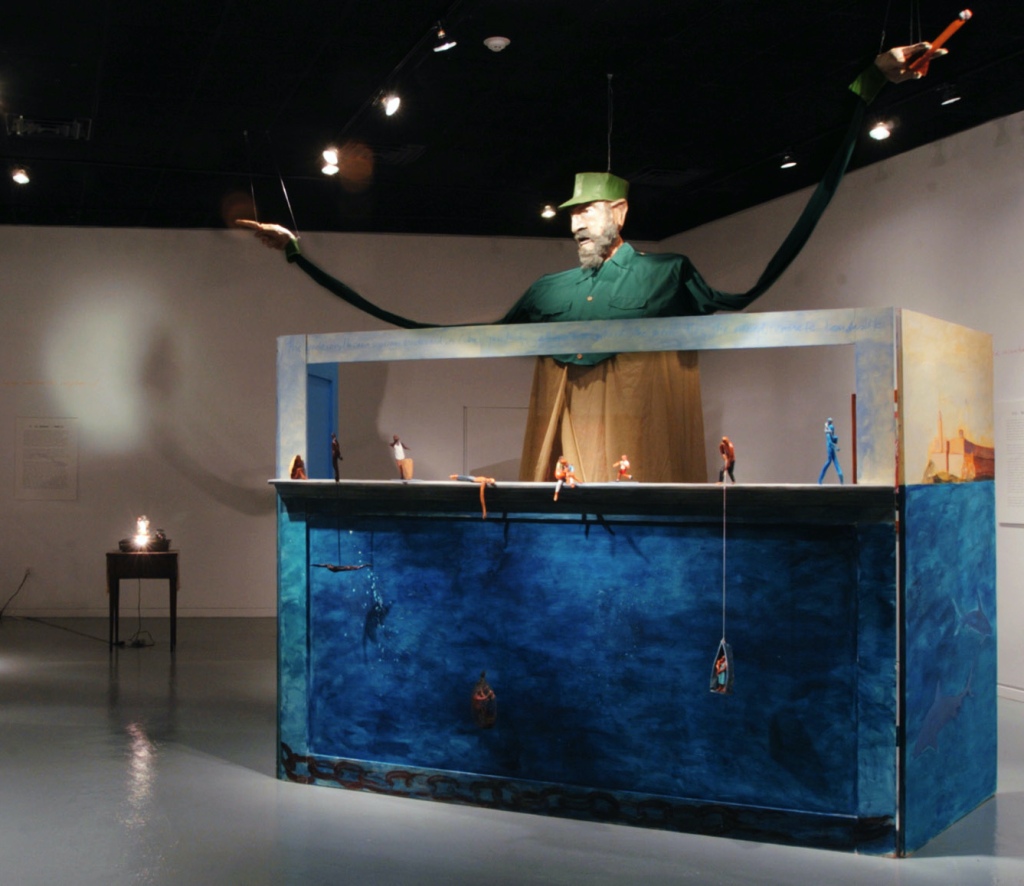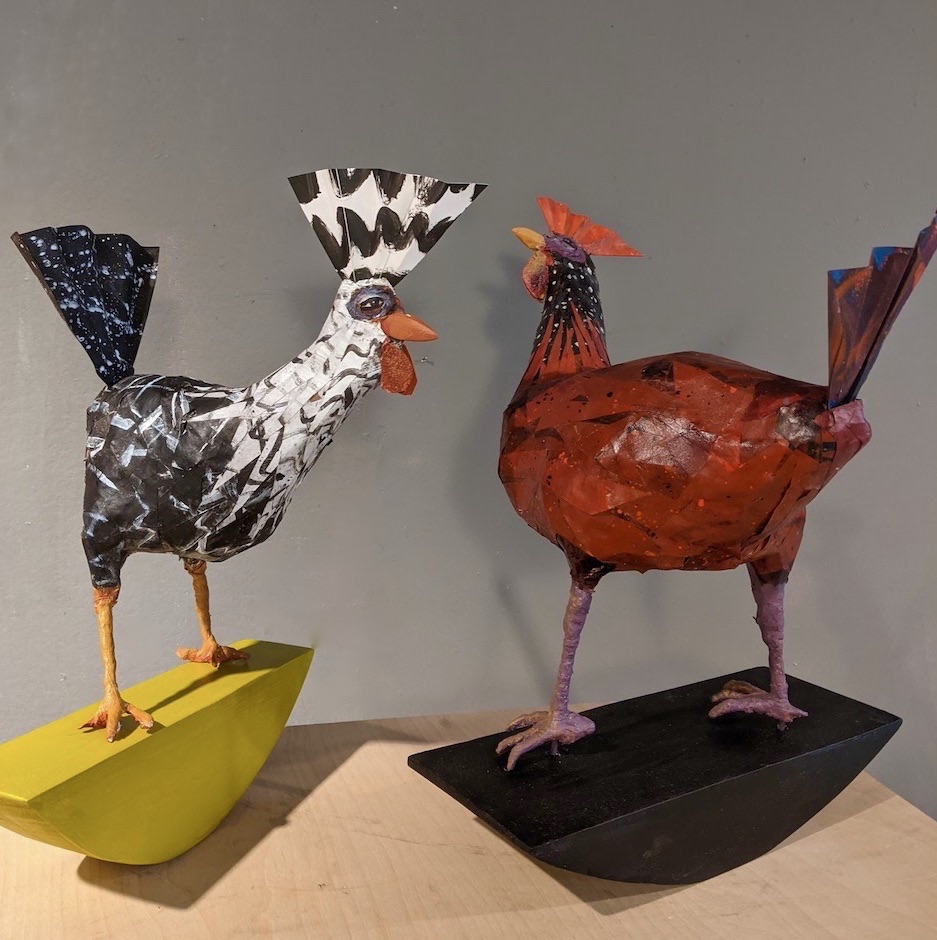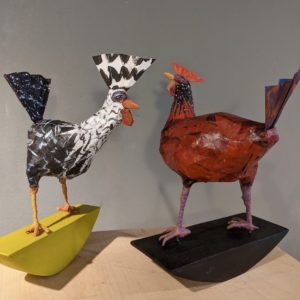Paper Mache, Politics, and Pandemic Therapy
This past month I’ve been working in paper mache– I call it my therapeutic diversion for the pandemic. Studio time begins by immersing my hands in a vat of glue solution and papering my flock of chickens. Yes. chickens, funny chickens. Other deadlines loom, like finishing up wood and aluminum sculptures in preparation for a solo show in 2021. But I was losing my focus. So I needed to do these, they are my therapy. They are allowing me to get refocused and back to the “serious work”.
I did a similar chicken series a decade ago, I called them my “Cuban Chickens”. That flock was part of my traveling art installation, “Cuba Journal”. The multimedia installation was my response to the first trip back to Cuba after 40 years. I was born there and my family fled the revolution in 1962. In 2002 I returned to bicycle around the island for three weeks.
The “Cuba Journal” exhibition was dominated by a large paper mache puppet of Castro. He was illuminated such that his shadow filled much of the space. There were other wooden sculptures, paintings, and a flock of paper chickens under his shadow. That show traveled throughout the United States for four years, it went to museums, universities, and galleries. My hope was that Castro’s reign, five decades and counting, might end during that time. Then I would burn that puppet as an effigy when he died. That was a fanciful idea, it would be a cathartic, artistic gesture, releasing my family and so many families from his shadow.

But reality is never so neat as art. Both my parents died before he did. Castro finally died in December 2016, but within weeks Donald Trump was installed as president of the United States. My gut response was that I was not free of dictators in my life. So I put off burning Castro.
After four hellish years under Trump and on the eve of Biden’s inauguration, I’m back to making chickens. Why? Because we’ve been living under the shadow of a president who in other countries would be called a dictator. And like all of his other authoritarian cronies, he’s refusing to leave office. I’m making them because in order to survive the gravitas and dangers of the moment I need to bring up joy, I need to laugh. I need to keep my mental health and immune system from crashing.
My funny chickens are doing that. Dipping my hands in the glue solution for paper mache, whether it’s flour and water, or glue and water, is a really messy business. I get fully engaged and momentarily forget whatever worries are buzzing around my head. The simple, repetitive process of building up the layers of small paper strips is meditative. My mind wanders to more joyful times. I remember being a young mother making piñatas with our two children for their birthdays. What grand messes we would make and what fun we had making sharks, rats, and surreal creatures. I think we finally stopped at age twelve. I also remember being a young artist and making large scale public piñatas for special events. Some of those events almost caused riots. The breaking of a piñata has a violence to it which you can only control with small numbers.
Paper mache is an ancient medium, Though it has a french name which means “chewed paper” it actually originated in China. China is where paper was invented. Examples have been found that date back to the Han Dynasty, BC 200. The Chinese figured out how to build up thin layers then lacquer them to make all kinds of sculptural forms. They even made helmets with it. I don’t know that I would trust going into war with a paper mache helmet. But then some of my pinatas became impenetrable with layers of glue medium and two by fours were needed to break them.
Working in paper mache also makes me think of one of my favorite artists, Peter Schumann, the creator and genius behind Bread and Puppet Theater. Schumann’s material for his theatrical dramas has always been paper mache. I’ve read that his glue elixer includes beer. The large scale collaborative puppet dramas are always focused on mythic stories and on the injustices in the world. His first dramas and protest parades were about the Vietnam War. A few years ago I was able to see him in action on his farm in the Northeast Kingdom in Vermont. He was wearing overalls and a frumpy hat and tending a large earth oven where many many loaves of bread were baking. After the wonderful performance in the natural outdoor amphitheater, our crowd of 300 or more people was offered homemade bread. Bread has always been broken and served after each Bread and Puppet performance– bread to bring us together, bread to bring joy, bread to remind us to share, bread to take us beyond politics.
My paper mache process is not grand like Schumann’s but it is bringing me joy and to the people who are buying them. And something else has also begun to happen. As I clean up after my sessions I’ve started to use the leftover glue and paper to make another paper form, a flat, long, skinny form. It is now ten feet and still growing. It is a red tie.
Yes, you guessed it. My second effigy for the second dictator in my life is coming to life without much serious thought or effort. And this January 20th I will light the match under it. Castro’s effigy can wait a little longer. The last dictator hired, first fired.
Paper Mache, Politics, and Pandemic Therapy Read More »

